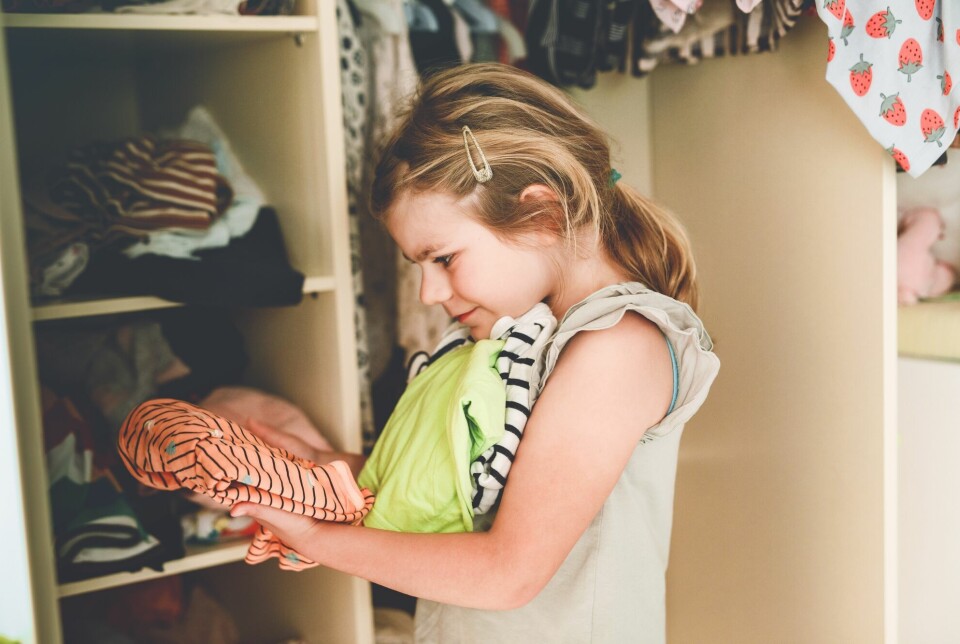
Norwegian kids don’t want school uniforms, but they all wear the same trousers
Researchers visited the homes of 12-year-olds and looked through their wardrobes.
To get the 12-year-olds in the wardrobe study to start thinking about clothes, researcher Ingrid Haugsrud asked them if they could imagine wearing a school uniform.
A few of the youngsters imagined that uniforms might involve pleated skirts and shirts like they had seen in American high school movies, and that it could be sort of fun. But everyone agreed that they would rather choose what to wear themselves.
Most viewed
No content
One of the clothing items that ranked high for a lot of them were velour trousers from the brand Juicy Couture.
“Some of the study participants had one such pair of trousers that they might have saved for or wanted for a special occasion, while others had seven pairs,” Haugsrud says.
Even though the children rejected the idea of a school uniform, they weren’t keen to stand out through their clothes.
“Other research on children and their consumer habits supports this finding as well. The most important thing is for the clothes to have just the right fit. You don't want to wear anything that’s too big or too small, and it shouldn't be too trashy or too nice,” Haugsrud says.
“Clothes should be right in the middle. Kids want what the others have. They don’t want to stand out.”
What's cool in class
The group of children who opened their wardrobes to the researchers consisted of nine youngsters, evenly divided between boys and girls. Some lived in Oslo's West End, others in the East End. Some lived with both mum and dad, others split their time between two homes.
The study is part of the Belong project at OsloMet, which explores social belonging among children from different backgrounds.
It turned out not to be that important if the kids from the West End had more Juicy trousers and a good deal more outdoor equipment and clothes than the kids in the East End.
“All the children, regardless of where they lived, felt that they had what they needed to fit in where they lived,” Haugsrud says.
Belonging wasn't about East or West, however.
“Fitting in is a very local thing, sometimes even down to the classroom level,” says Haugsrud, but she adds that interviews with older children could have yielded completely different responses.
But what if a child didn't have those particular trousers?
Haugsrud notes that the children were cautious in their remarks, showing a heightened awareness on this topic.
“They’ve heard a lot both at home and at school about being allowed to wear what you want and not judging each other. So they expressed themselves carefully when they talked about it. Yet, having what's popular matters. And even if someone has seven of an item, it's enough to have one. A sweater that’s cool, or the right brand. And it can be secondhand, it doesn't have to be brand new,” she says.
Comfy clothing preferred
Besides the Juicy Couture trousers, hoodies were singled out as many kids’ favourite garment. They like their clothes to be comfortable and soft, a bit like wrapping yourself in something warm and cosy.
The clothes that children didn't like were ones that felt stiff or itchy.
“In general, people base why they like or don't like certain clothes on how they feel on the body,” Haugsrud says.
“This applies to adults, too. The body is the yardstick for what feels good and comfortable.”
Especially the boys in the study were concerned that the clothes had to work well for physical play. For example, some pants were much better for sliding on snow than others.

Mum's domain
Several of the children were involved in cleaning out their outgrown clothing and deciding what should be donated to recycling and what to give to the girl next door. They went along to shop for clothes so that they would end up with what they wanted. The girls found shopping fun and the boys thought it was boring, but knew that it had to be done.
And mothers were in charge of these activities.
“It was quite clear that it was the mothers who ensured that wardrobes were well-stocked,” Haugsrud says.
“Some children lived with mum and dad every other week, but dad wasn’t mentioned in the interviews in those cases, either.”
This pattern is also clear in other research. Clothing is the domain of women – not just for themselves and their children, but for everyone in the family.
“Mum was the one who knew when it was time to refresh the wardrobe – she went shopping for clothes, she tackled cleaning out the outgrown things with the children, and she made sure that the clothes were appropriate for the season,” Haugsrud says.
Just fit in
It's easy to smile when children say they don't want a school uniform, yet they all wear the same trousers. But adults are also like that, according to clothing researcher Haugsrud.
“We wear the same jeans and knitted sweaters. Fitting in is a basic need for adults and children,” she says.
A lot of the research on clothing has traditionally focused on fashions and subcultures. Haugsrud's study is about everyday life.
“Fitting in is really important for everyone, but we haven't talked much about that in clothing research in the past. A lot of people are content being ordinary and don’t aspire to stand out. They want to be just right," she says.
Clothes and social exclusion
Beate Goldschmidt-Gjerløw is a teacher, writer, and researcher affiliated with the University of Agder. Her research has included how to teach about controversial and sensitive topics in school, related to body, gender, and sexuality. She is not involved in the OsloMet project Belong.
“It’s a small study, and I think that the findings are valid for this group of participants,” Goldschmidt-Gjerløw tells sciencenorway.no.
“At the same time, I think the study is incredibly important because we need to know more about how children and young people experience the connection between clothes, social belonging, and exclusion."
———
Translated by Ingrid P. Nuse
Read the Norwegian version of this article at forskning.no
































